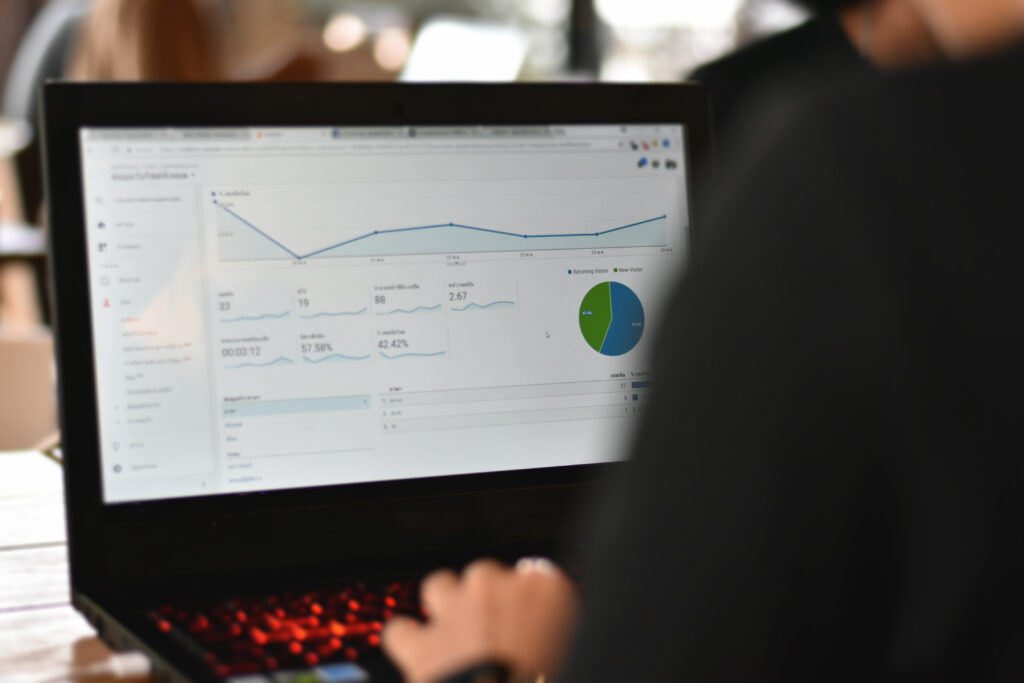For any business with a website — which at this point should include any and every type of business — tracking metrics around user interactions with your website is key. There are countless tools on the market for analyzing and categorizing website data, but one remains the top pick for most marketers and business owners: Google Analytics.
Google Analytics is a free tool that makes tracking and analyzing visitors to your website simple. On the surface level, Google Analytics offers basic reporting that transforms data into digestible reports. Dive deeper, and experts in the tool can utilize it to build incredibly robust customized reports.
If you haven’t yet implemented Google Analytics into your marketing strategy, we are here to help you understand why you should and how you can best use this tool to your advantage. We’ll even cover brand-new tips on the upcoming transition from Google Universal Analytics to Google Analytics 4. Dive in and discover more about your customers.

What Is Google Analytics?
Google Analytics is a free website analytics tool provided by Google. It gives those who run a website or app insights into the traffic visiting them. Google Analytics collects information, including the amount of traffic visiting your website, where traffic is coming from, and the behavior of visitors once they land on your website.
The beauty of Google Analytics is that it is useful for everyone, from a beginner user to a professional data analyst. Within it, there are multiple layers of data, and once you set up Google Analytics to run on your website, it will continually add to the data set. You can use it for basic reporting, or you can work with a professional to set up customized, detailed reports. At zero cost, it is a no-brainer to hook up any website to this handy tool.
Universal Analytics Vs. Google Analytics 4
When discussing Google Analytics, it is important to note that the platform is undergoing a major transition. In 2005, Google Analytics was born when the search engine giant acquired Urchin Software Corp. Urchin had an analytics platform called Urchin on Demand, which Google used as the foundation for what they would rebrand as Google Analytics.
Over the years, Google has continued to add updates to its analytics tool. Notably, in 2012, Google released Universal Analytics (UA), and this term has been used synonymously with Google Analytics since.
Now, Google is transitioning away from UA to a new version of its tool called Google Analytics 4 (GA4). While transitioning from UA to GA4 has been optional for users up to this point, Google has recently announced that UA will be officially discontinued on July 1, 2023. Not only is it important for businesses to make the change before this date, but UA data will not be migrated into GA4. This means that if a user wishes to see historicals year-over-year, they will need to make the switch as soon as possible. The earlier you move to GA4, the better insights you’ll have. If you aren’t sure which version of the tool is connected to your website, ask your webmaster or the agency managing your analytics.
With GA4, there are a few notable changes. For starters, in UA, reporting focused on visitors to your website. For companies with apps, this data was tracked separately. With GA4, both website and app data are unified into one reporting area.
Additionally, in response to privacy law changes and consumer concerns, GA4 has been adapted to meet these new regulations. GA4 uses improved machine learning and offers actional reporting with built-in insights. For the purposes of this guide, we’ll use GA4 and Google Analytics interchangeably.
Why Should You Use Google Analytics?
There are numerous reasons why you should use Google Analytics, and with the tool being free to anyone with a website, it doesn’t hurt to give it a try. Some of the benefits of implementing Google Analytics include the following:
- Measure your marketing strategies: With Google Analytics, you can discover what marketing tactics are actually delivering results. From what channels are driving new users to your website to what pages are resulting in conversions, Google Analytics makes it easier to measure your marketing strategies.
- Understand user behaviors: Without an analytics tool, measuring your website’s performance can be difficult. Are people able to navigate it easily? Do users know how to contact you for a quote? Through Google Analytics, you are no longer guessing about user behaviors.
- See the big picture: Often, the benefits of a marketing strategy cannot be seen immediately. With Google Analytics, you can track trends and measure impact year-over-year, providing a holistic view of your strategy.
Top Most Valuable Google Analytics Reports and How to Use Them
Once you set up Google Analytics, you’ll be greeted with a robust dashboard that offers you both simple overviews of information and the ability to dig deep into data and build custom reports. For those who are just getting started, it can be helpful to navigate through a few of the most useful built-in reports.
1. Acquisition Reports
Perhaps one of the most useful and easy-to-digest reports in the new GA4 dashboard is the acquisition report. Located under “Life cycle,” you can use this report to quickly analyze the channels that are driving traffic to your site, such as organic search, direct, referral, paid search, unassigned, display, email, paid shopping, organic social, and organic video.
While you can set up your own custom reports within Acquisition, Google Analytics will come set up with the following built-in reports:
- Acquisition overview: This will summarize all of your acquisition data and help you understand the overarching themes of where your website and app traffic is coming from. If you integrate Google Analytics with Google Ads, you’ll also see a platform-specific summary card that will showcase the impact of specific campaigns.
- User acquisition: This report will showcase information about the channels that are delivering new users to your website. You can use this data to understand what channels are providing you with your latest visitors.
- Traffic acquisition: Rather than breaking down the data by new user, traffic acquisition is a report that reflects where new sessions are coming from. This could be a user who has already visited your website. This data indicates how returning and new users are finding your website.
With just these basic reports, you can learn a lot of valuable information about how your website is performing. For example, if you notice that most of your new users are coming from paid ads and very few are coming from organic search, you might see room for improvement. Perhaps by investing in improved SEO tactics, you could drive more organic traffic to your site, lowering your acquisition costs over time.
There are countless ways you can put these reports to work, and the more familiar you become with Google Analytics, the more opportunity you have for customizing the reports to meet your needs.
2. Demographic Overview
Found under the User section of Google Analytics, the Demographics report is fairly similar to what users of Universal Analytics are used to seeing. This report is extremely helpful in providing more information about the type of visitors you have. Demographics reports will break down your users by age, location, and gender. It will also provide information about the interests those users have demonstrated through online purchases and searches.
To enhance this data further, be sure to activate Google signals. Google signals collects data from users who are signed into their Google account and have activated Ad Personalization in their account. Google collects more holistic demographic and interest data from these users. If you have activated Google signals, this data will be fed into your Google Analytics demographic data.
To learn more about activating Google signals, follow Google’s step-by-step instructions here: Activate Google signals.
Demographic reports can help you discover more about your customers. You can use this data to build customer personas, which can help you adjust your marketing strategies and improve your messaging.
3. Engagement Reports
Finally, another report worth diving into is the Engagement overview. To access this report, click on Reports and then Engagement in the left-hand navigation. This report measures user engagement based on key events, such as conversions and page visits. You can use this report to understand what pages have the most user engagement and dive further into how users behave throughout a visit to your website.
The Engagement reports are extremely beneficial in helping you understand what pages perform the best and what pages lead to conversions. This report might also provide insights into where your website needs improvement. For example, if you notice a trend that visitors are dropping off after visiting your home page, you might need to consider why that is occurring and take action to better use this web page to drive action.

Tips for Making the Most Out of Google Analytics
Google Analytics is a powerful tool for business owners. However, navigating the tool can, at first, feel overwhelming. Follow these tips to help you get the most out of Google Analytics:
1. Take a Google Analytics Course
If you want to gain a better understanding of how Google Analytics works, it might be worth your time to take the free Google Analytics courses offered by Google. Since UA is being phased out, the best use of your time is to start the GA4 courses.
The great part about these courses is that they are free, and you can do them at any pace. You can choose to complete a few basic courses or go all the way and become certified. We highly recommend that new users complete at least the first few courses.
2. Pull Reports Frequently
The reports in Google Analytics are only useful if you read them. And the more time you spend in the tool, the more comfortable you’ll become with navigating the reports.
Set up a time at least once a week to visit your report dashboard. This will help you pick up on trends and can alert you to any concerning changes in your website traffic.
3. Work with an Agency that Specializes in Google Analytics
Finally, for many business owners, the reality is that there is simply not enough time in a day to dive as deep into Google Analytics as you’d like. Working with a marketing agency that specializes in Google Analytics can help you get the most out of the tool. Often, agencies can set up custom reports for you and translate data sets into actionable insights.
To learn more about Google Analytics and how our team can help, reach out to J&L Marketing today. We will be happy to share with you how we use this powerful tool to assist our customers in learning more about their website’s performance and their customers.



